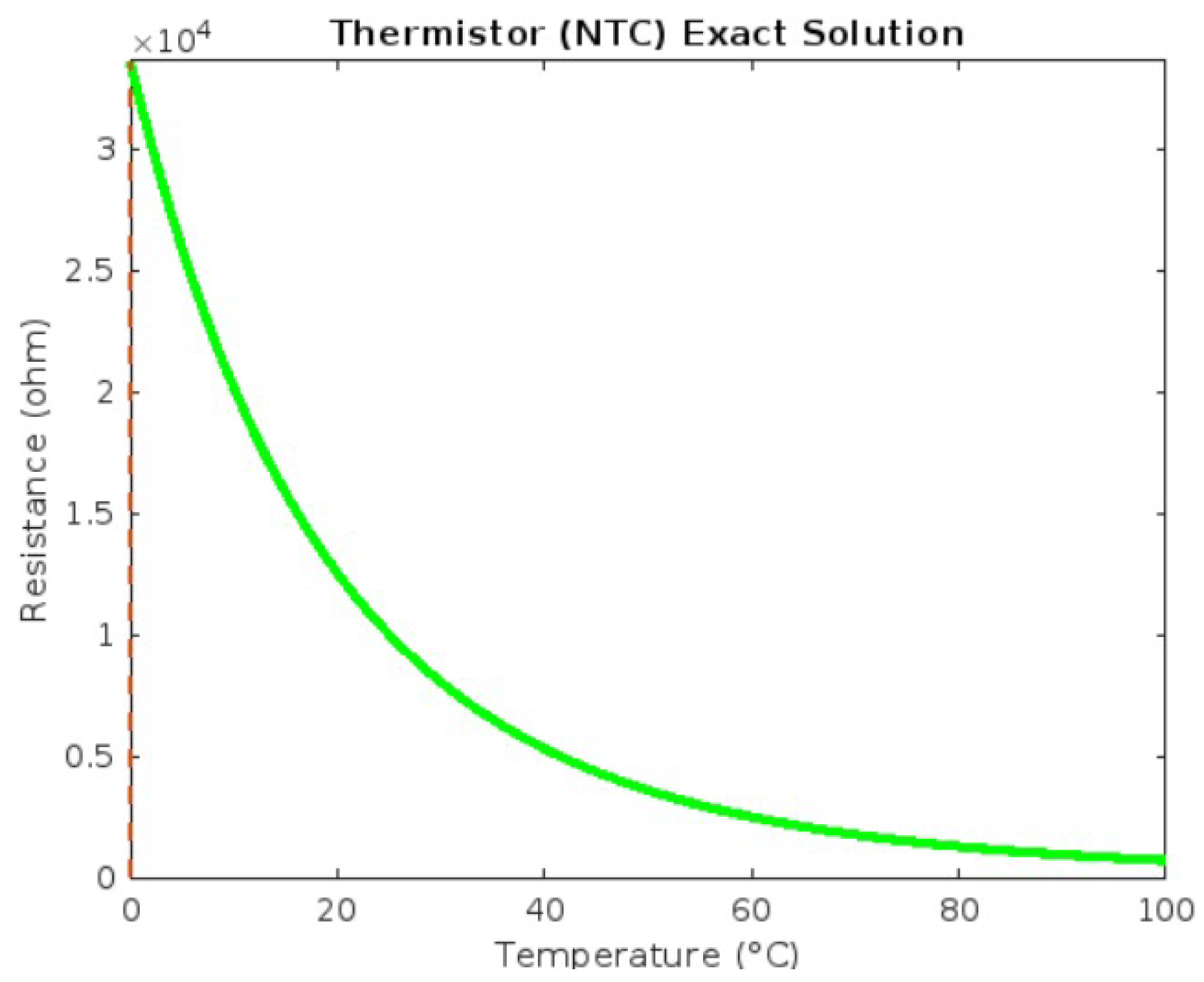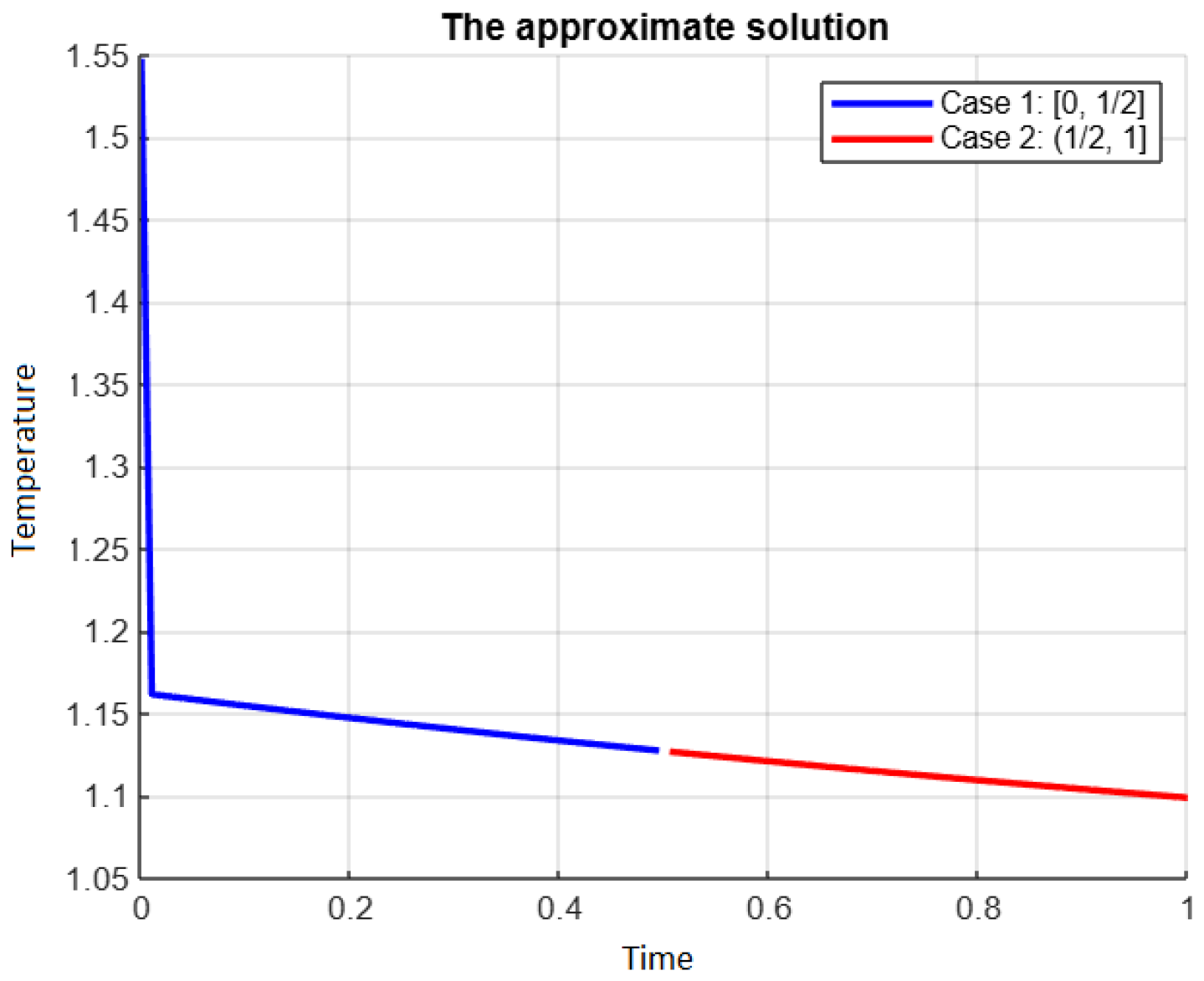Existence of Solutions to the Variable Order Caputo Fractional Thermistor Problem
Abstract
1. Introduction
2. Basic Concepts
- (i)
- is called a generalized interval if it is either a standard interval, a point, or ∅.
- (ii)
- If S is a generalized interval, then the finite set consisting of generalized intervals contained in S is called a partition of S provided that every lies in exactly one of the intervals in the finite set .
- (iii)
- We say that the function is piecewise constant with respect to the partition of S, if for any , ℵ is constant on .
3. Main Results
- ℵ is continuous;
- , , for all and ;
- , for all and ;
- For
4. An Example
5. Discussion
Author Contributions
Funding
Data Availability Statement
Conflicts of Interest
References
- Allegretto, W.; Xie, H. A nonlocal thermistor problem. Europ. J. Appl. Math. 1995, 6, 83–94. [Google Scholar] [CrossRef]
- Antontsev, S.N.; Chipot, M. The thermistor problem: Existence, smoothness, uniqueness, blowup. SIAM J. Math. Anal. 1994, 25, 1128–1156. [Google Scholar] [CrossRef]
- Lacey, A.A. Thermal runaway in a nonlocal problem modelling ohmic heating: Part I: Model derivation and some special cases. Europ. J. Appl. Math. 1995, 6, 127–144. [Google Scholar] [CrossRef]
- Mazzouz, K.; Henderson, J. Existence and uniqueness of solutions for a Caputo-Katugampola fractional thermistor problem. Commun. Appl. Nonlinear Anal. 2021, 28, 43–56. [Google Scholar]
- Kuttler, K.L.; Shillor, M.; Fernandez, J.R. Existence for the thermoviscoelastic thermistor problem. Differ. Equations Dynam. Syst. 2008, 16, 309–332. [Google Scholar] [CrossRef]
- Ammi, M.R.S.; Torres, D.F.M. Existence and uniqueness results for a fractional Riemann-Liouville nonlocal thermistor problem on arbitrary time scales. J. King Saud Univ. Sci. 2018, 30, 381–385. [Google Scholar] [CrossRef]
- Ammi, M.R.S.; Jamiai, I.; Torres, D.F.M. Global existence of solutions for a fractional Caputo nonlocal thermistor problem. Adv. Differ. Equ. 2017, 2017, 363. [Google Scholar] [CrossRef]
- Ammi, M.R.S.; Torres, D.F.M. Existence of solution to a nonlocal conformable fractional thermistor problem. Commun. Fac. Sci. Univ. Ank. Ser. A1 Math. Stat. 2019, 68, 1061–1072. [Google Scholar] [CrossRef]
- Vivek, D.; Kanagarajan, K.; Sivasundaram, S. Dynamics and stability results for Hilfer fractional type thermistor problem. Fractal Fract. 2017, 1, 5. [Google Scholar] [CrossRef]
- Allegreto, W.; Lin, Y.; Ma, S. Existence and long time behaviour of solutions to obstacle thermistor equations. Discret. Contin. Dyn. Sys. 2002, 8, 757–780. [Google Scholar] [CrossRef]
- Allegreto, W.; Lin, Y.; Zhou, A. A box scheme for coupled systems resulting from microsensor thermistor problems. Dynam. Contin. Discret. Impuls. Systems 1999, 5, 209–223. [Google Scholar]
- Chen, X. Existence and regularity of solutions of a nonlinear degenerate elliptic system arising from a thermistor problem. J. Partial Differ. Equ. 1994, 7, 19–34. [Google Scholar]
- Cimatti, G. Remark on the existence and uniqueness for the thermistor problem under mixed boundary conditions. Quart. J. Mech. Appl. Math. 1989, 47, 117–121. [Google Scholar] [CrossRef]
- Howison, S.D. A note on the thermistor problem in two space dimension. Quart. J. Mech. Appl. Math. 1989, 47, 509–512. [Google Scholar] [CrossRef][Green Version]
- Howison, S.D.; Rodrigues, J.; Shillor, M. Stationary solutions to the thermistor problem. J. Math. Anal. Appl. 1993, 174, 573–588. [Google Scholar] [CrossRef]
- Xie, H.; Allegretto, W. Cα( ) solutions of a class of nonlinear degenerate elliptic systems arising in the thermistor problem. SIAM J. Math. Anal. 1991, 22, 1491–1499. [Google Scholar] [CrossRef]
- Xu, X. The thermistor problem with conductivity vanishing for large temperature. Proc. Roy. Soc. Edinb. Sect. A 1994, 124, 1–21. [Google Scholar] [CrossRef]
- Xu, X. Local regularity theorems for the stationary thermistor problem. Proc. Roy. Soc. Edinb. Sect. A 2004, 134, 773–782. [Google Scholar] [CrossRef]
- Caoa, J.; Qiub, Y. A high order numerical scheme for variable order fractional ordinary differential equation. Appl. Math. Lett. 2016, 61, 88–94. [Google Scholar] [CrossRef]
- Kutluay, S.; Bahadir, A.R.; Özdeş, A. A variety of finite difference methods to the thermistor with a new modified electrical conductivity. Appl. Math. Comput. 1999, 106, 205–213. [Google Scholar] [CrossRef]
- Kutluay, S.; Esen, E. A B-spline finite element method for the thermistor problem with the modified electrical conductivity. Appl. Math. Comput. 2004, 156, 621–632. [Google Scholar] [CrossRef]
- Shi, D.; Yang, H. Superconvergence analysis of finite element method for time-fractional thermistor problem. Appl. Math. Comput. 2018, 323, 31–42. [Google Scholar] [CrossRef]
- Bahadir, A.R. Application of cubic B-spline finite element technique to the thermistor problem. Appl. Math. Comput. 2004, 149, 379–387. [Google Scholar] [CrossRef]
- Kutluay, S.; Wood, A.S. Numerical solutions of the thermistor problem with a ramp electrical conductivity. Appl. Math. Comput. 2004, 148, 145–162. [Google Scholar] [CrossRef]
- Zhou, S.; Westbrook, D.R. Numerical solutions of the thermistor equations. J. Comput. Appl. Math. 1997, 79, 101–118. [Google Scholar] [CrossRef]
- Samko, S.G. Fractional integration and differentiation of variable order. Anal. Math. 1995, 21, 213–236. [Google Scholar] [CrossRef]
- Samko, S.G.; Ross, B. Integration and differentiation to a variable fractional-order. Integral Transform. Spec. Funct. 1993, 1, 277–300. [Google Scholar] [CrossRef]
- Valério, D.; da Costa, J.S. Variable-order fractional derivatives and their numerical approximations. Signal Process. 2011, 91, 470–483. [Google Scholar] [CrossRef]
- Sun, H.; Chang, A.; Zhang, Y.; Chen, W. A review on variable-order fractional differential equations: Mathematical foundations, physical models, numerical methods and applications. Fract. Calc. Appl. Anal. 2019, 22, 27–59. [Google Scholar] [CrossRef]
- Lakshmikantham, V.; Vatsala, A.S. Basic theory of fractional differential equations. Nonlinear Anal. 2008, 69, 2677–2682. [Google Scholar] [CrossRef]
- Zhang, S. The uniqueness result of solutions to initial value problems of differential equations of variable-order. Rev. R. Acad. Cienc. Exactas Fis. Nat. Serie A Mat. 2018, 112, 407–423. [Google Scholar] [CrossRef]
- Granas, A.; Dugundji, J. Fixed Point Theory; Springer: New York, NY, USA, 2003. [Google Scholar]


Disclaimer/Publisher’s Note: The statements, opinions and data contained in all publications are solely those of the individual author(s) and contributor(s) and not of MDPI and/or the editor(s). MDPI and/or the editor(s) disclaim responsibility for any injury to people or property resulting from any ideas, methods, instructions or products referred to in the content. |
© 2025 by the authors. Licensee MDPI, Basel, Switzerland. This article is an open access article distributed under the terms and conditions of the Creative Commons Attribution (CC BY) license (https://creativecommons.org/licenses/by/4.0/).
Share and Cite
Graef, J.R.; Maazouz, K.; Pinelas, S.; Bellabes, Z.; Boussekkine, N. Existence of Solutions to the Variable Order Caputo Fractional Thermistor Problem. Fractal Fract. 2025, 9, 139. https://doi.org/10.3390/fractalfract9030139
Graef JR, Maazouz K, Pinelas S, Bellabes Z, Boussekkine N. Existence of Solutions to the Variable Order Caputo Fractional Thermistor Problem. Fractal and Fractional. 2025; 9(3):139. https://doi.org/10.3390/fractalfract9030139
Chicago/Turabian StyleGraef, John R., Kadda Maazouz, Sandra Pinelas, Zineb Bellabes, and Naima Boussekkine. 2025. "Existence of Solutions to the Variable Order Caputo Fractional Thermistor Problem" Fractal and Fractional 9, no. 3: 139. https://doi.org/10.3390/fractalfract9030139
APA StyleGraef, J. R., Maazouz, K., Pinelas, S., Bellabes, Z., & Boussekkine, N. (2025). Existence of Solutions to the Variable Order Caputo Fractional Thermistor Problem. Fractal and Fractional, 9(3), 139. https://doi.org/10.3390/fractalfract9030139







